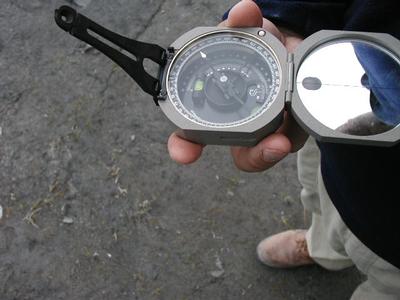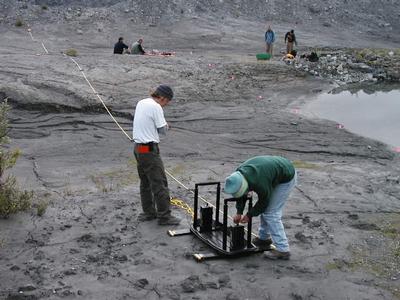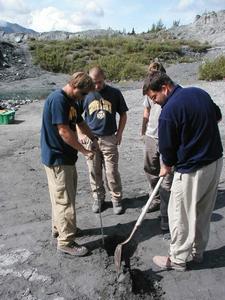25 July, 2001
Laundry and Collecting Data
9:50 p.m.
Even though we spent the day collecting lots of good data, I feel a bit
guilty writing today's journal... I am camping AND I am clean AND my clothes
are clean.
Life on ice ... almost
After an early rise and a long day of data collection, Kendra, Justin and I
snuck out to Grand View, an RV park, cute restaurant and coin shower &
laundry.
The "fruit of the forest" pie and giant scoop of ice cream were nice, the
clean clothes are good, and the warm shower was outstanding. Feeling really
clean and camping are things I rarely experience together (and then only at
the beginning of camping trips!)
Ahhhhh.....
To come back to loving campmates who kindly saved food for us and
rain-proofed our tents (my sleeping bag was hanging on a tree, boots were
airing out, etc.) is proof of the teamwork and goodwill that can pervade a
smoothly running field camp.
Science at work
We took a brief hiatus (break) from our project to help Justin collect
data he will need for his work after we leave. We used GPR to look for the
presence of ice in the moraine, and if it's there, where it is. Ice layers
trapped in the moraine can tell us about the history of the glacier, how
quickly moraines form and how sediment finally ends up being deposited (this
is important to help us understand how glaciers have deposited in much of
North America)
The curious thing about today's work is how mundane (plain) it was.
Justin and Kendra pulled the antennae along in one sled and the computer and
battery in another, stopping every 25 cm over 15 lines (each about 40 m
long). I numbered survey flags (which will be used later to very accurately
survey the location and elevation of the area we imaged today). If the work
does not sound exotic or challenging, it is because it was not exotic or
challenging. It was grunt work.
And grunt work is sometimes the key to good science.
By collecting data that no one has collected before, we will discover new
things. Maybe those new things will confirm what is already known and maybe
(just maybe) that data will revolutionize how we think about the moraines,
glaciers, Earth's history and science. The point is, you don't know until
you try; and trying begins by collecting the data.
I am going to collect data on sleep patterns in rainy weather. I'll keep you
posted on the results.
Cheers.
~SM

The fiber optic wires that attach the antennae to the computers are extremely fragile (they are made of glass!). No twisting, crimping, stepping on, etc. Here Nelson and Kendra are carefully unwinding the wires.

Nelson is using a brunton to find the orientation (north, south, east, west), the strike (direction of slopes) and the dip (steepness of slopes).

Greg displays a rock hammer, another essential tool for geologists.

Kendra and Justin making adjustments to the Sled of Science.

It may look like Nelson and Nick are digging a hole (with supervisory help from Michael). Geologists call it ground truth, and use it to test points of their data as confirmation that their hypotheses about what is underground are true.
Contact the TEA in the field at
.
If you cannot connect through your browser, copy the
TEA's e-mail address in the "To:" line of
your favorite e-mail package.
|
